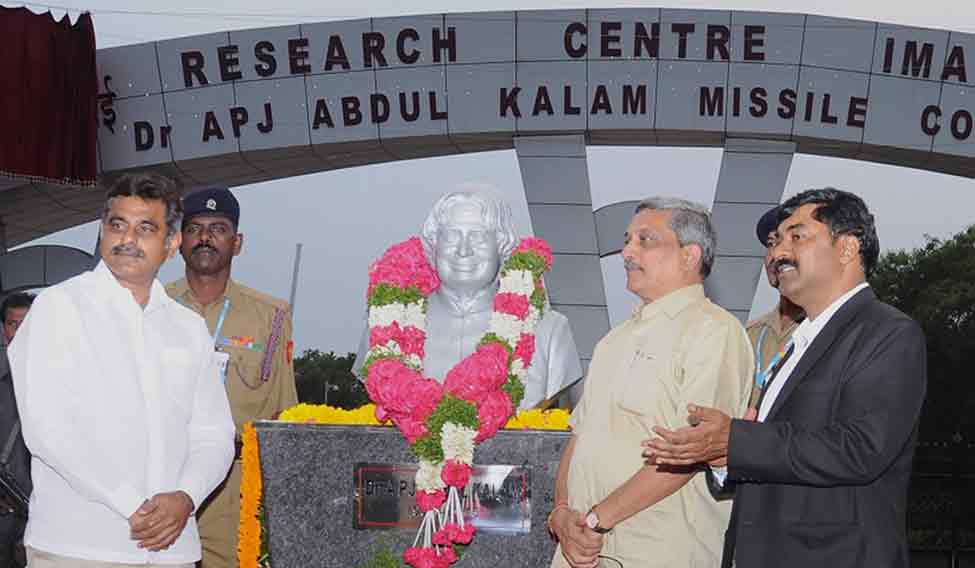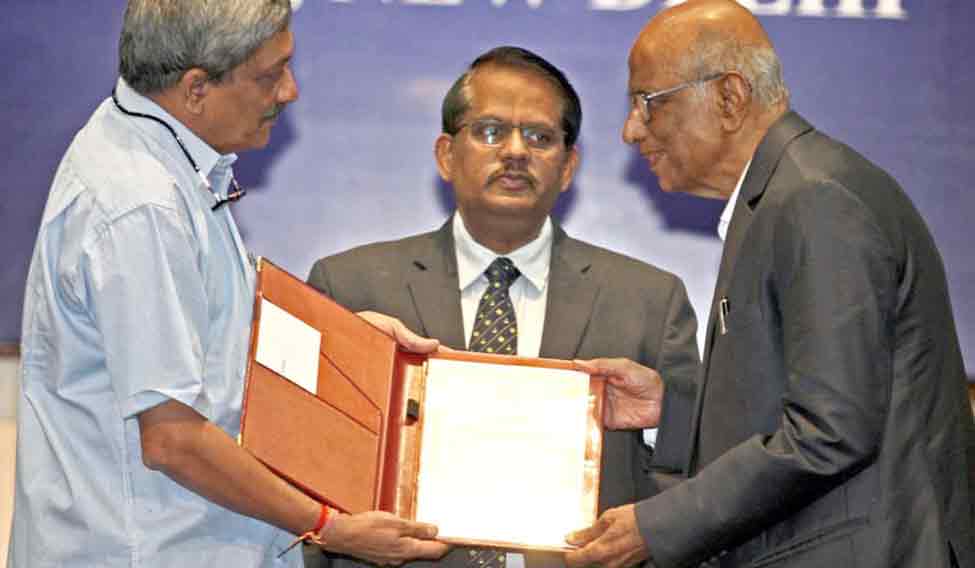Before he became president, Dr A.P.J. Abdul Kalam powered India's missile programme and made Indians proud of the Defence Research and Development Organisation. As a tribute, the DRDO named its missile complex in Hyderabad after him last year. The complex comprises the Advanced Systems Laboratory, the Defence Research and Development Laboratory (DRDL) and the Research Centre Imarat (RCI).
On Kalam's 84th birthday—October 15, 2015—Defence Minister Manohar Parrikar renamed the complex and unveiled a bust of the late president at the RCI. On the same day, Telangana Chief Minister K. Chandrasekhar Rao unveiled another Kalam bust at the DRDL.
The first bust was the initiative of G. Satheesh Reddy, director of the RCI and scientific adviser to the defence minister. The second was planned by DRDL Director K. Jayaraman. Interestingly, DRDO Director General S. Christopher came to know about the functions from the media.
DRDO headquarters felt that it had been snubbed by the labs. C.P. Ramanarayanan, chief controller of the DRDO's human resources wing, wrote to all labs that the failure to obtain “formal approval [for the functions]... has been viewed seriously by the department”. It is now mandatory for labs to get permission at least 15 days before an event. And, invitations can be sent out only after the approval comes through.
Prabhu Dandriyal, whistleblower and former DRDO employee, said it was not the first face-off between the Christopher and Reddy camps. Earlier, the DRDO director general held two additional posts: scientific adviser to the defence minister and secretary in department of defence research and development. The Narendra Modi government discontinued this practice and appointed Reddy scientific adviser.
Many old hands like Ravi Gupta, former DRDO spokesperson and senior scientist, have been opposed to the bifurcation. “Many key projects, some of them strategically vital, could have their existence only because of the three-in-one hat,” Gupta said.
The bifurcation of designations was essentially done to reform the DRDO. While the organisation has hits like the long-range nuclear missiles Agni and Prithvi, it has quite a few high-profile misses, too, like the Tejas light combat aircraft and the Arjun main battle tank. While Tejas and Arjun cannot be classified as duds, they have fallen way short of the mark and this has affected the Air Force and the Army.
The Modi government wanted greater synergy between the armed forces and the DRDO. So, on May 29, 2015, the government bifurcated the posts. Not only has there been no synergy post-bifurcation, but also the feud between Reddy and Christopher has affected the DRDO. Senior officials, too, are confused about who heads specific functions of the DRDO. An insider said that even Deputy National Security Adviser Arvind Gupta was once stumped. Gupta was in touch with Reddy for discussing key defence research and development projects. Then, he was told that it was Christopher who was actually running the show.
 Show down: (From right) Satheesh Reddy with Parrikar and Vishweshwar Reddy, MP from Chevella | PIB
Show down: (From right) Satheesh Reddy with Parrikar and Vishweshwar Reddy, MP from Chevella | PIB
MULTIPLE SOURCES POINTED out the lack of clarity about what is expected of the scientific adviser. The Union government's rules of business allocation define the work to be done by a government official. But, there is no such document on the scientific adviser's responsibilities.
Informally, the scientific adviser is expected to advise the government on scientific aspects of military equipment and logistics, and on the formulation of research, design and development plans for equipment required by the three services.
However, there seems to be a disconnect between Reddy and the latest technological developments in the DRDO, as he does not have direct access to the labs. And, he has been missing departmental review meetings and the conference of directors, which all directors in the DRDO are expected to attend. This is surprising, considering that Reddy continues to be director, RCI.
Officials close to Reddy claim that he is not invited to meetings held by Christopher, including reviews of special projects. Sources close to Christopher say Reddy is invited, but he excuses himself. Once when Christopher held a review meeting at the RCI, Reddy, instead of attending it, went to visit a school in his home town. Reddy's dual role is reportedly slowing down the RCI, which develops seekers for missile systems.
Reddy supporters say the snubs are not one-sided, and that he has been kept away from panels for appointing heads of key labs and projects.
Parrikar has been trying hard to bring the feuding duo together. He gives Reddy all proposals of joint technological developments with foreign countries and discusses all technology projects with him. The minister recently tightened the screws on the medium-range surface-to-air missile programme headed by Reddy, after he found that agencies within the defence ministry were not keeping the DRDO in the loop, resulting in cost escalation.
It is, perhaps, unfair to blame the current feud solely on Christopher and Reddy, because it is all rooted in the Union government's unceremonious dismissal of DRDO chief Avinash Chander in January 2015. The government wanted a younger DRDO chief.
Two seniors jumped into the fray, but were passed over—Anil Datar, the 59-year-old director general of armament and combat engineering systems, and Satish Kumar, the 58-year-old chief controller of technology management. On May 29, 2015, the appointments committee of cabinet picked Christopher. As director at the centre for airborne systems, he had helped develop an airborne early warning and control system.
As part of its strategy to revamp the DRDO, the government had also decided against extending the tenure of lab directors. But, it has not yet done much towards revamping the DRDO's 49 labs, which are often criticised for huge time and cost overruns.
In 2007, a committee was formed to revamp the DRDO; the chair was Dr P. Rama Rao, former secretary, department of science and technology. It submitted its report in February 2008 and recommended that the DRDO should focus only on eight to ten “critical technologies” of “strategic importance”, instead of making everything from dental implants and mosquito repellents to nuclear missiles and fighter jets.
History sheet
Problems faced by DRDO chiefs
* Avinash Chander was fired in January 2015, though his contract was to end only on May 31, 2016. No explanation was given by the prime minister's office.
* V.K. Saraswat wanted an extension to complete work on the air defence missile system, but was denied. He apparently had differences with defence minister A.K. Antony.
* M. Natarajan, who had worked on the Arjun MBT programme, wept at a meeting attended by defence minister A.K. Antony and services chiefs. He had to be consoled by another DRDO veteran, A. Sivathanu Pillai. Natarajan said the Army top brass ridiculed his presentation on Arjun.
* V.S.R. Arunachalam was accused of promoting American interests, after retirement. But, he was backed by then prime minister P.V. Narasimha Rao.







